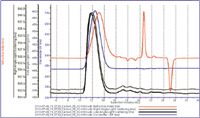Analysis of Carbon-Filled Polyethylene by Advanced Triple Detection High Temperature Gel Permeation Chromatography (HT-GPC)
Malvern Instruments Ltd.
Polyethylene containing 10% carbon black is prepared and analyzed by HT-GPC and the sample is automatically filtered at high temperature to remove the filler. The results of seven repeat measurements are tabulated to show that the performance of the system was not affected by the high carbon filler content.
Polyethylene (PE) properties are highly dependent on the molecular weight, and analysis of this parameter by gel permeation chromatography (GPC) is vital for research and quality control. The main challenge in this analysis is the requirement for aggressive solvents and temperatures of 140–160 °C to keep PE in solution. In addition, any inorganic fillers present must be removed by filtration at 140–160 °C which normally represents a practical and health and safety challenge.
Sample Preparation and Experimental Conditions
About 30 mg of the carbon-filled PE was weighed into a 40 mL vial and TCB (1,2,4-trichlorobenzene) was added before placing into the heated autosampler at 160 °C to dissolve.
During injection, and before entering the GPC column, the sample is filtered automatically to remove the carbon filler. The GPC analysis was carried out at 150 °C in TCB at 1 mL/min.

Figure 1: High temp-GPC triple detection chromatogram for "Carbon PE".
Results
Table I demonstrates the precision of the analysis of the carbon filled PE showing that the performance of the system was unaffected by analyzing this material.

Table I: Quantitative results for carbon-PE analyzed by HT GPC and calculated by triple detection method
Mw: Weight average molecular weight (Dalton)
Mn: Number average molecular weight (Dalton)
Mw/Mn: Polydispersity
IV: Intrinsic Viscosity (dl/g)
Rh: Hydrodynamic Radius (nm)
Conclusion
The carbon filled sample was successfully analyzed by the Viscotek HT-GPC system and reproducible results were obtained and reported. The presence of the carbon black filler in the samples had no detrimental impact on the analysis and was successfully removed by the automatic filtration system. This means that filled polyolefins can now be analyzed by HT-GPC with minimal sample preparation and no bulk sample filtration.
Reference
Application Note MRK1646-01, Malvern Instruments Knowledgebase article.
Malvern Instruments Ltd.
Enigma Business Park, Grovewood Road, Malvern, UK
tel. +44 (0) 1684 892456
Website: www.malvern.com

SEC-MALS of Antibody Therapeutics—A Robust Method for In-Depth Sample Characterization
June 1st 2022Monoclonal antibodies (mAbs) are effective therapeutics for cancers, auto-immune diseases, viral infections, and other diseases. Recent developments in antibody therapeutics aim to add more specific binding regions (bi- and multi-specificity) to increase their effectiveness and/or to downsize the molecule to the specific binding regions (for example, scFv or Fab fragment) to achieve better penetration of the tissue. As the molecule gets more complex, the possible high and low molecular weight (H/LMW) impurities become more complex, too. In order to accurately analyze the various species, more advanced detection than ultraviolet (UV) is required to characterize a mAb sample.

.png&w=3840&q=75)

.png&w=3840&q=75)



.png&w=3840&q=75)



.png&w=3840&q=75)














